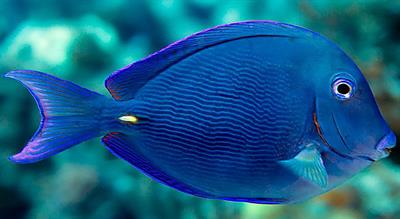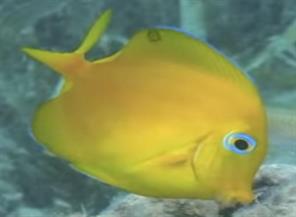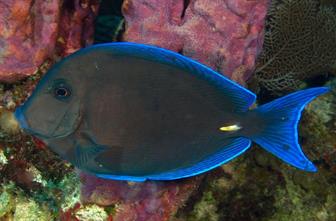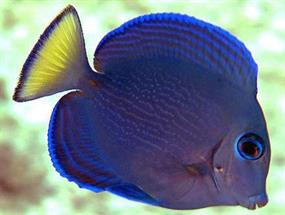




Acanthurus coeruleus
| Ecological Descriptors |
||||
| Habitat | Size (cm) | Diet | Behaviour | Sex |
| Co, R, | 39 | Veg | Sh (I) | F |
Description:
Adults: Body laterally compressed, oval in shape, with relatively long dorsal and anal fins and a crescent tail. Body blue overall, but can change from powder blue to deep purple, and pale or darken. Dorsal and anal fins edged in bright blue. Base of tail with a sharp spine (like a surgeon's scalpel), white or yellow in color. Spawning ,ales may display courtship white heads.
Intermediate: Intermediate stage with a blue head and body, but with a yellow tail.
Juveniles: Bright yellow overall. Changes from juvenile to intermediate and adult color phase are independent of the size, and sometimes a yellow phase juvenile may be larger than a blue-phased adult.
Ecology
Inhabits coral reefs, inshore grassy or rocky areas, down to 40 m. Can be solitary, but more often in large aggregations grazing on algae. Mainly diurnal. The sharp spines on both sides of the base tail are used as defensive weapons by slashing their tails from side to side. When not in use, they are folded backwards against the body. Juveniles occur primarily on the reef crest, spurs, and a transition zone between the reef crest and reef flat, but larger juveniles are more common in the back reef, while adults are evenly distributed across zones. It aggregates with other surgeonfishes (A. bahianus and A. chirurgus) to raid algae patches guarded by damselfishes.
Life Cycle:
It appears to normally mature at ~ 13 cm. This species has been observed to form late afternoon resident spawning aggregations of 6,000-7,000 individuals, possibly year-round. This species also pair spawns. The pair spawning male holds a benthic territory and develops an ephemeral 'white-faced' color phase. Mating is highly dependent on a few factors; currents, moon phase, the absence of predators, and suitability of location. Normally mating occurs at approximately 6-10 m deep where the currents are available to transport the fertilized eggs. When the female is ready to mate she changes her colour to a lighter blue. The process occurs when the males release gametes at the water surface and fertilization occurs after contact is made with the female. After the eggs hatch the larvae are then in the pelagic (openwater) stage. They then move inshore where they take approximately a week to develop into juveniles. After one year they reach sexual maturity and can then survive for 10-15 years
Adults: Body laterally compressed, oval in shape, with relatively long dorsal and anal fins and a crescent tail. Body blue overall, but can change from powder blue to deep purple, and pale or darken. Dorsal and anal fins edged in bright blue. Base of tail with a sharp spine (like a surgeon's scalpel), white or yellow in color. Spawning ,ales may display courtship white heads.
Intermediate: Intermediate stage with a blue head and body, but with a yellow tail.
Juveniles: Bright yellow overall. Changes from juvenile to intermediate and adult color phase are independent of the size, and sometimes a yellow phase juvenile may be larger than a blue-phased adult.
Ecology
Inhabits coral reefs, inshore grassy or rocky areas, down to 40 m. Can be solitary, but more often in large aggregations grazing on algae. Mainly diurnal. The sharp spines on both sides of the base tail are used as defensive weapons by slashing their tails from side to side. When not in use, they are folded backwards against the body. Juveniles occur primarily on the reef crest, spurs, and a transition zone between the reef crest and reef flat, but larger juveniles are more common in the back reef, while adults are evenly distributed across zones. It aggregates with other surgeonfishes (A. bahianus and A. chirurgus) to raid algae patches guarded by damselfishes.
Life Cycle:
It appears to normally mature at ~ 13 cm. This species has been observed to form late afternoon resident spawning aggregations of 6,000-7,000 individuals, possibly year-round. This species also pair spawns. The pair spawning male holds a benthic territory and develops an ephemeral 'white-faced' color phase. Mating is highly dependent on a few factors; currents, moon phase, the absence of predators, and suitability of location. Normally mating occurs at approximately 6-10 m deep where the currents are available to transport the fertilized eggs. When the female is ready to mate she changes her colour to a lighter blue. The process occurs when the males release gametes at the water surface and fertilization occurs after contact is made with the female. After the eggs hatch the larvae are then in the pelagic (openwater) stage. They then move inshore where they take approximately a week to develop into juveniles. After one year they reach sexual maturity and can then survive for 10-15 years
Blue Tang
Blue Tang
Juvenile
Juvenile


(C) Dr P Ryan/ RyanPhotographic
Blue Tang


(C) Kirk Kilfoyle

Blue Tang
Intermediate
Intermediate

103

102

